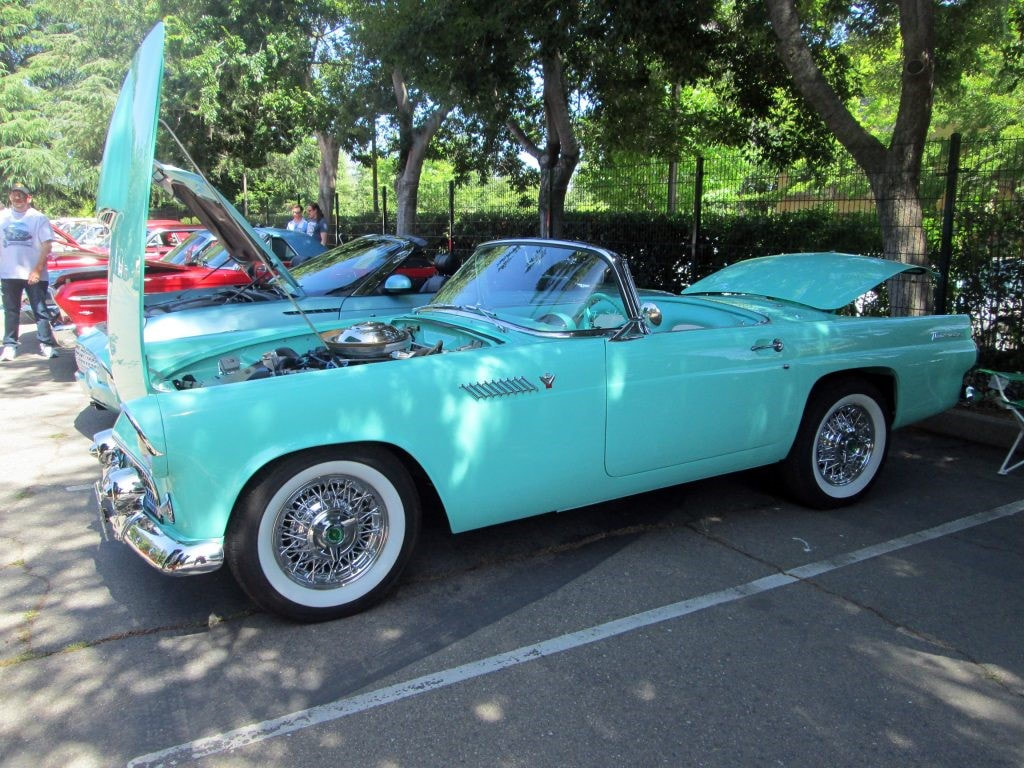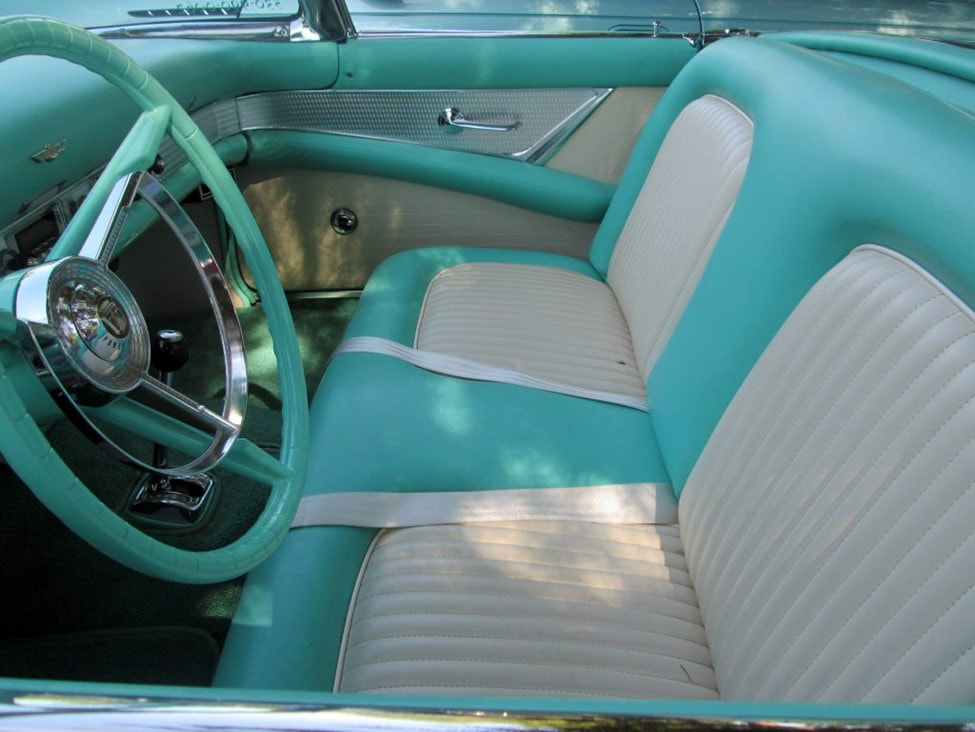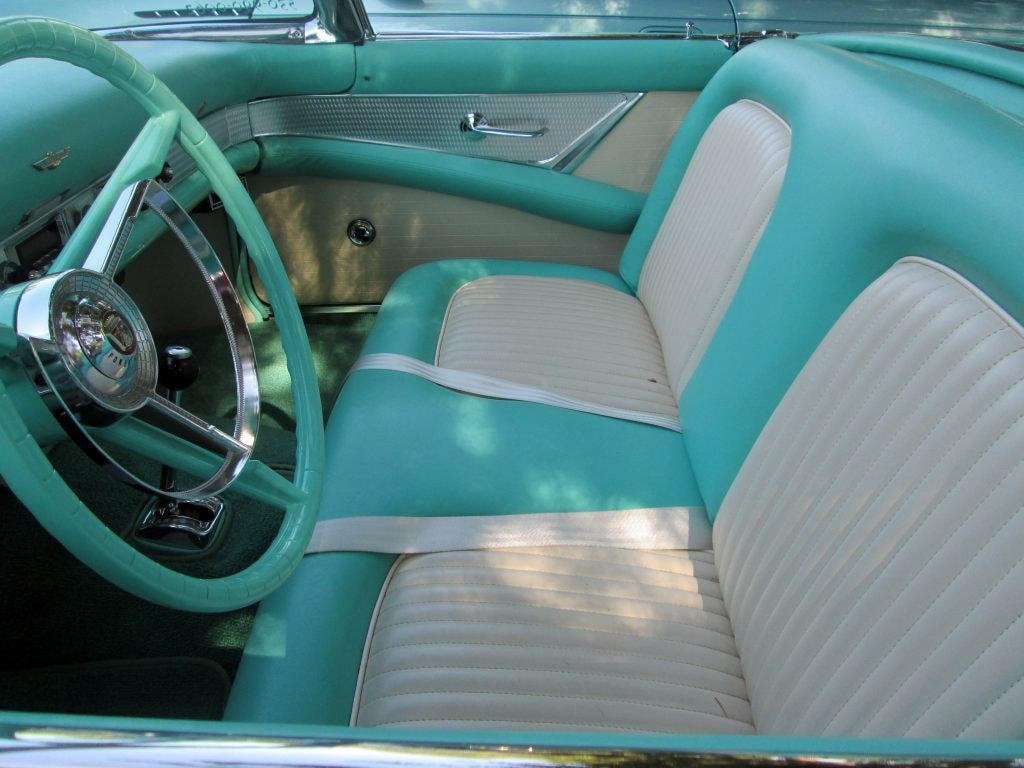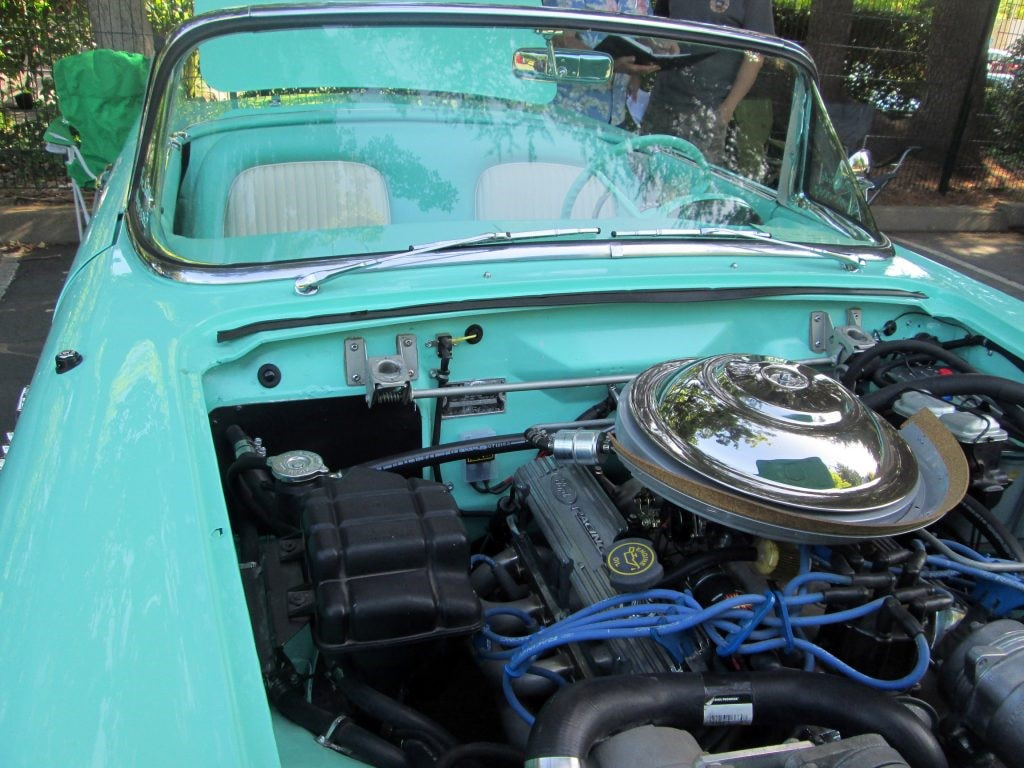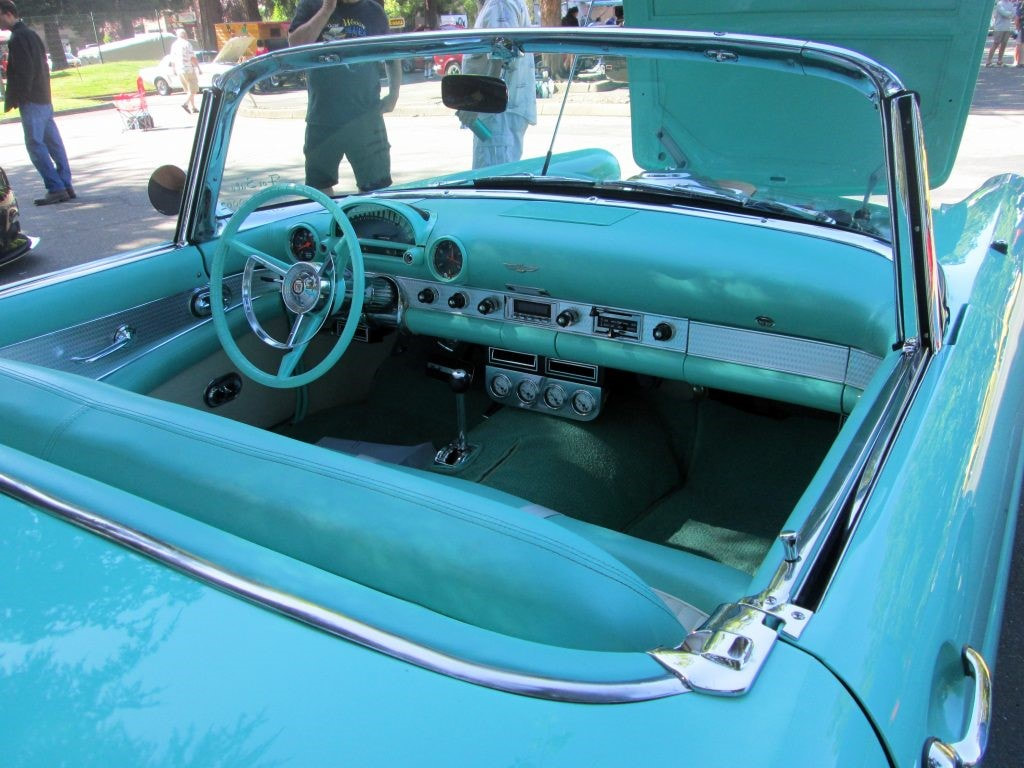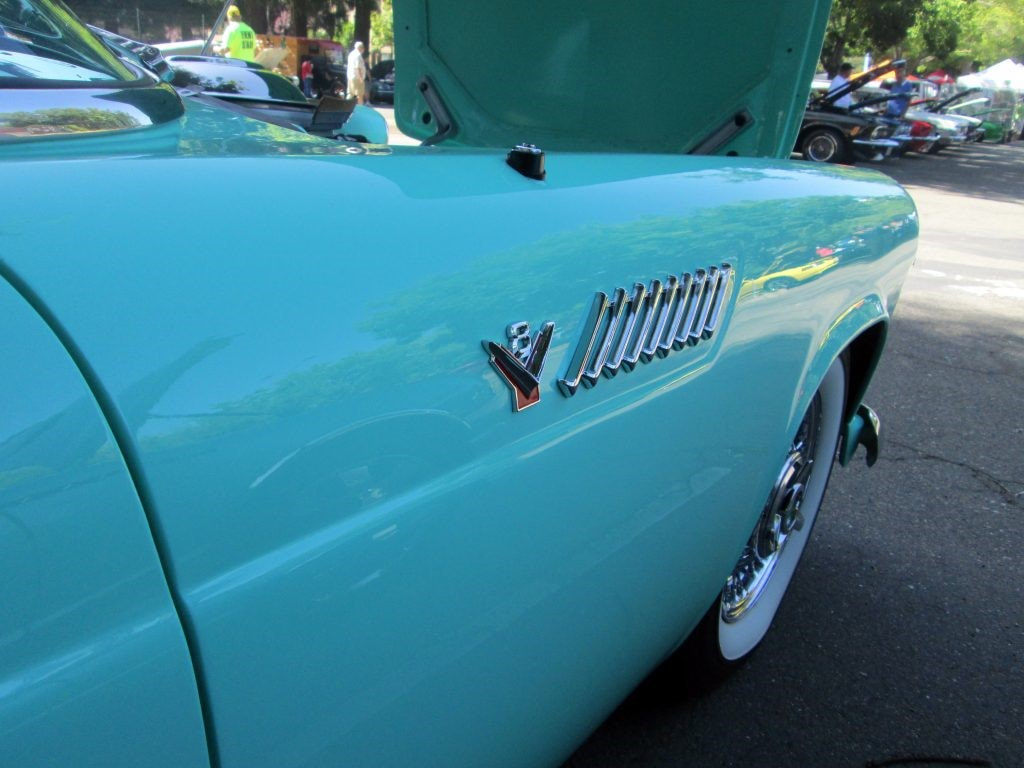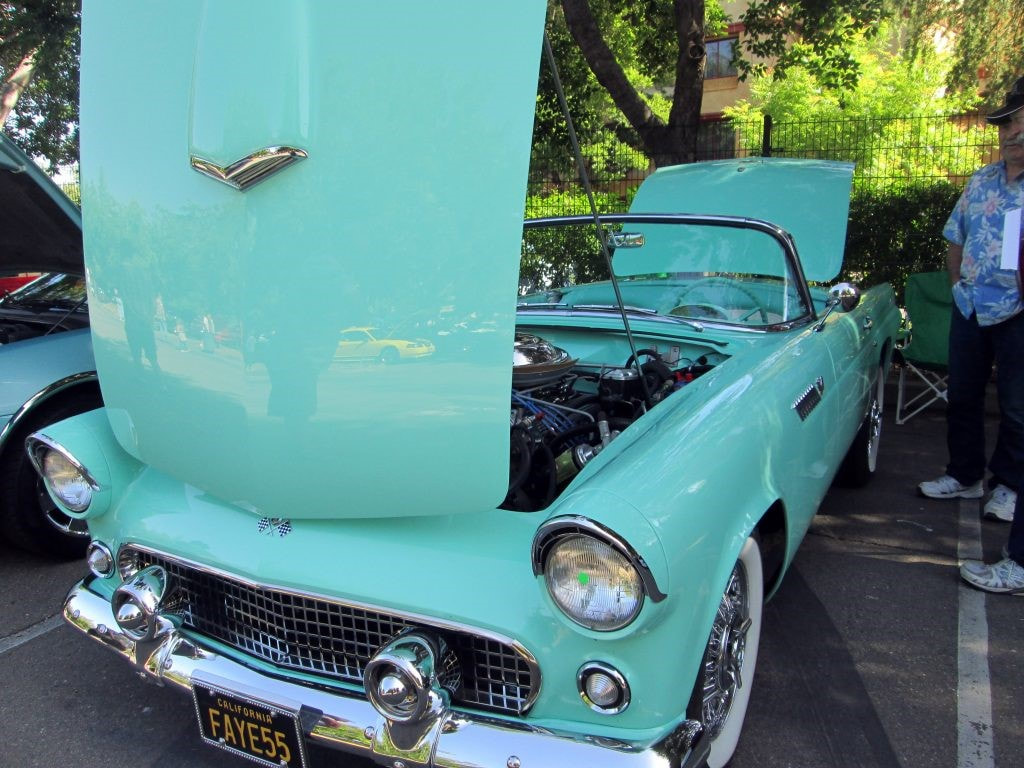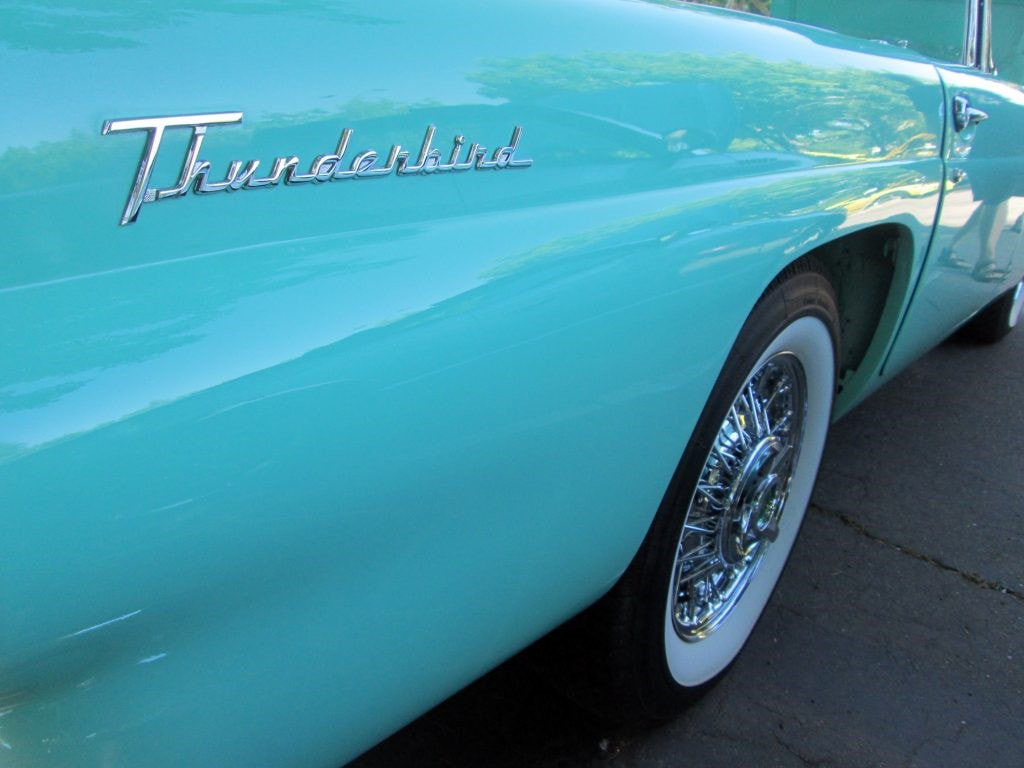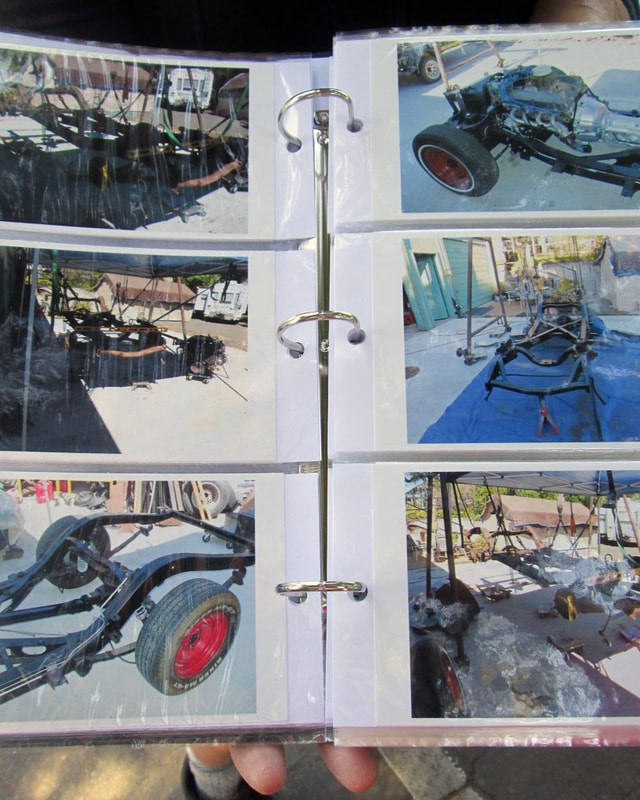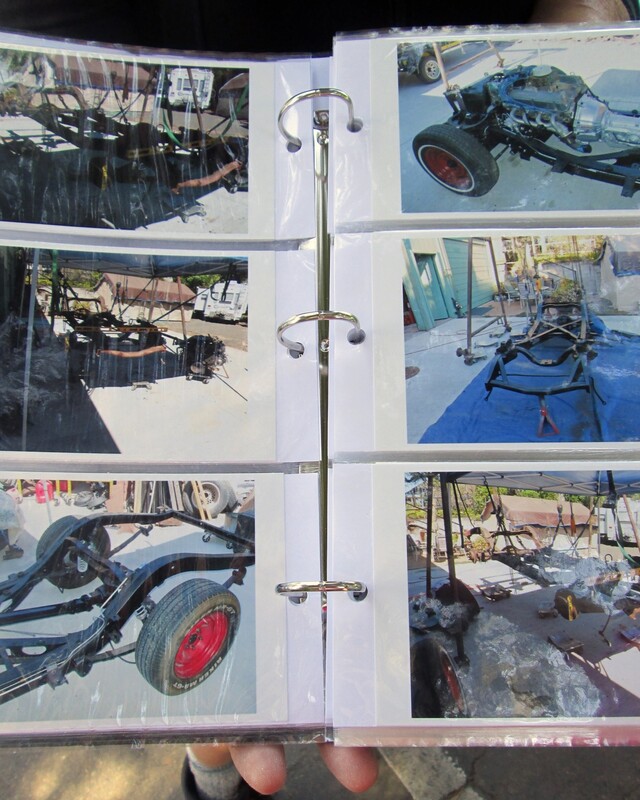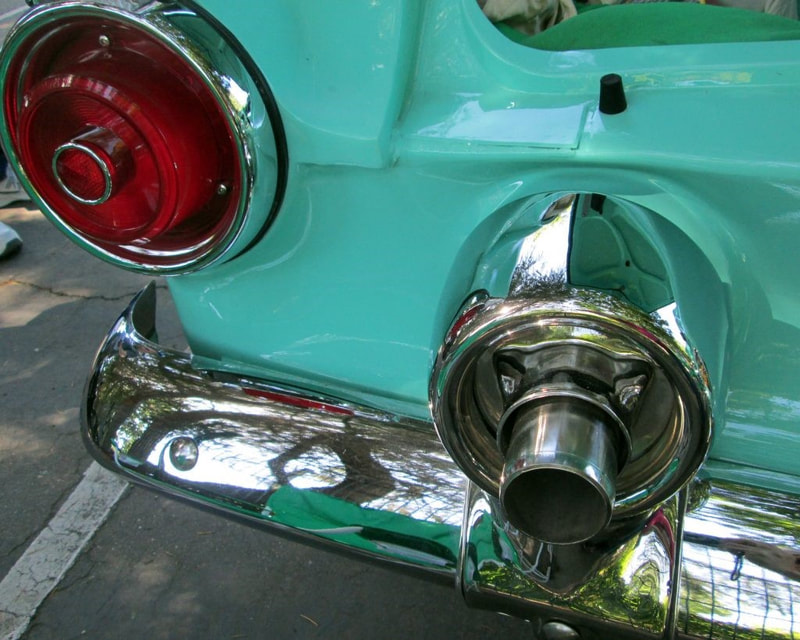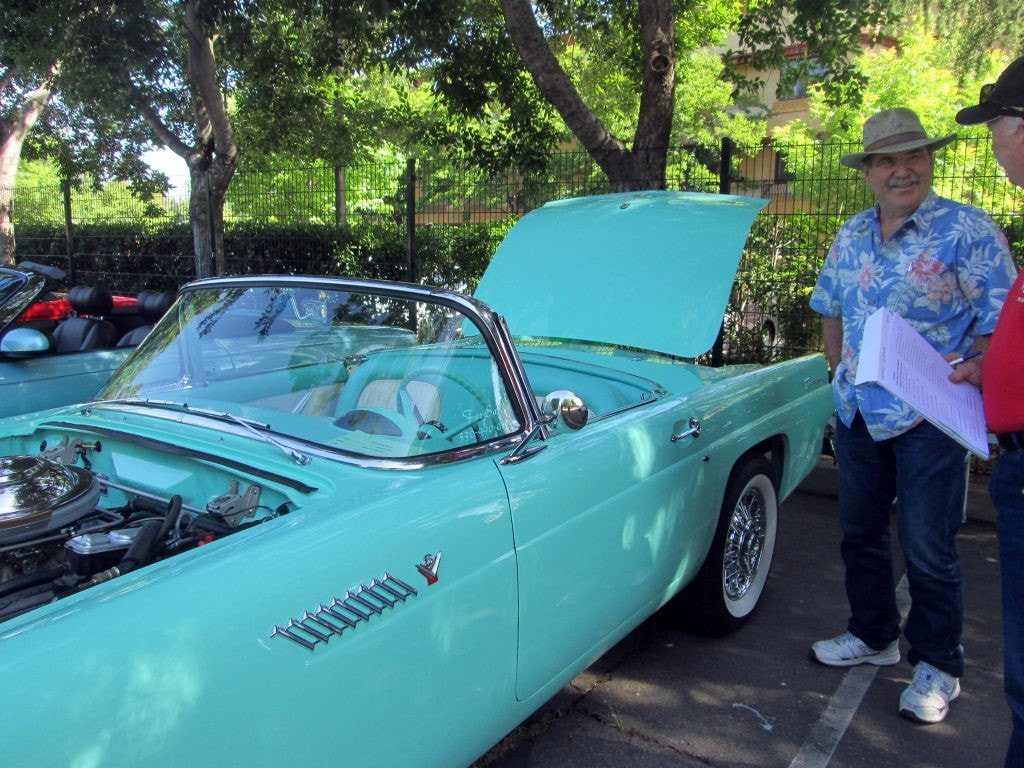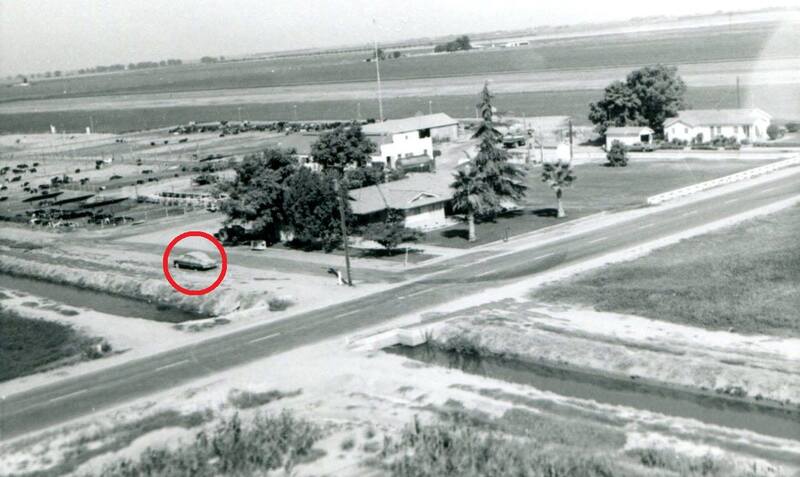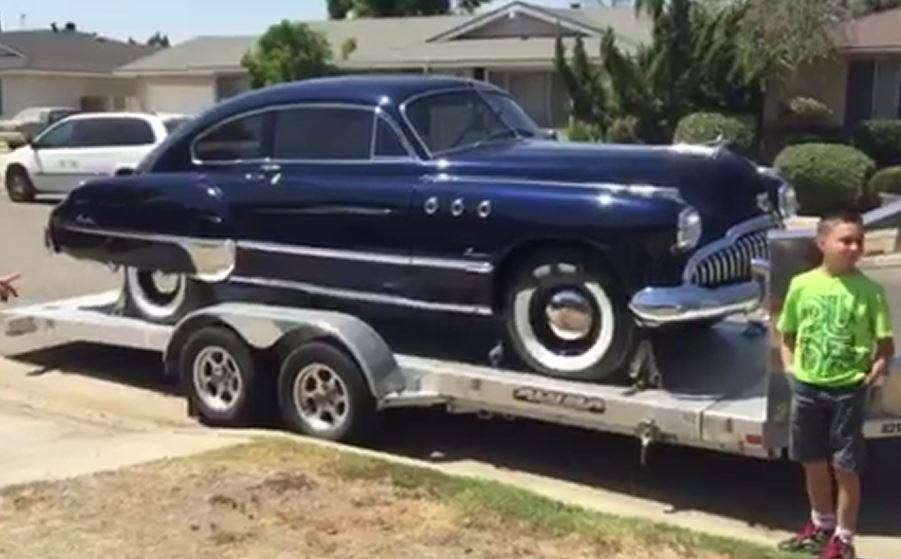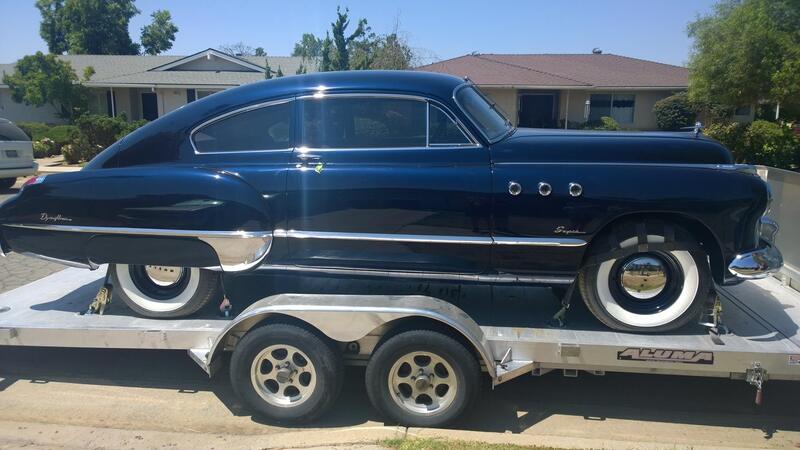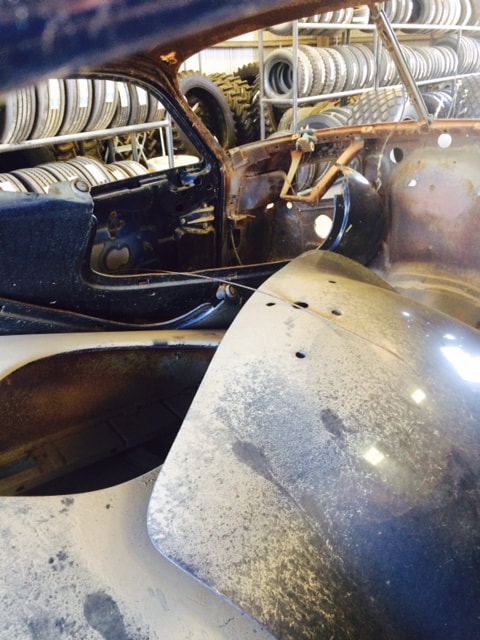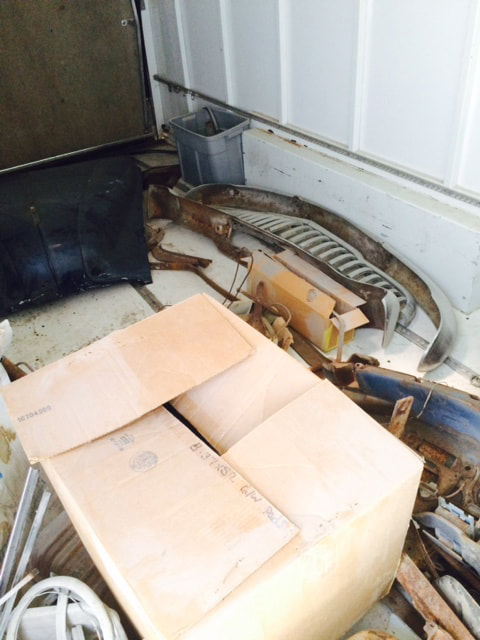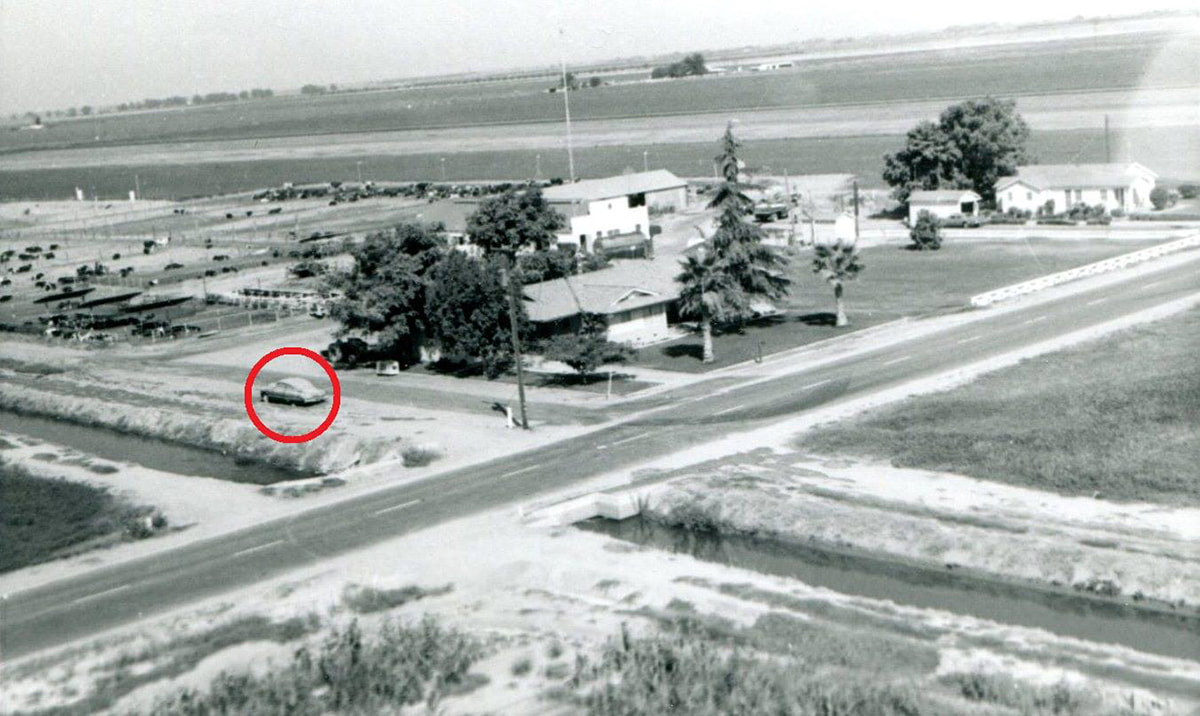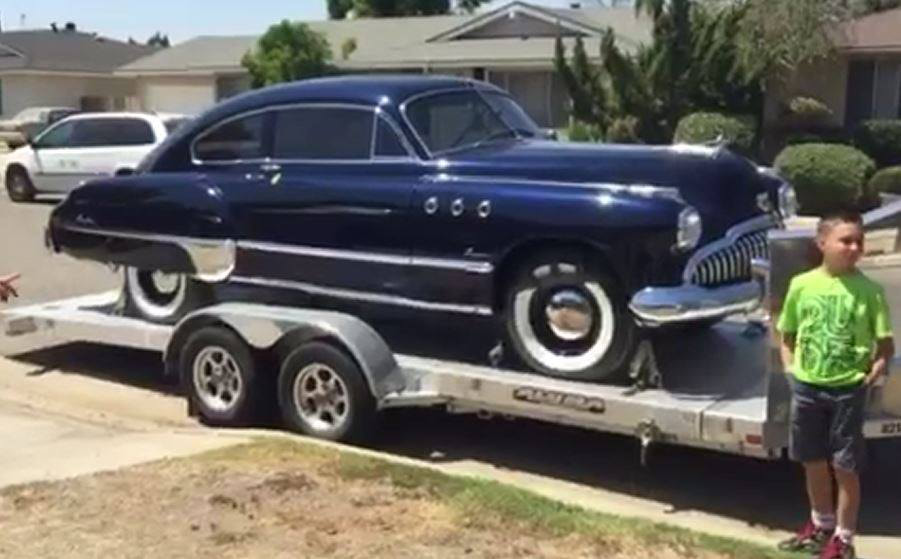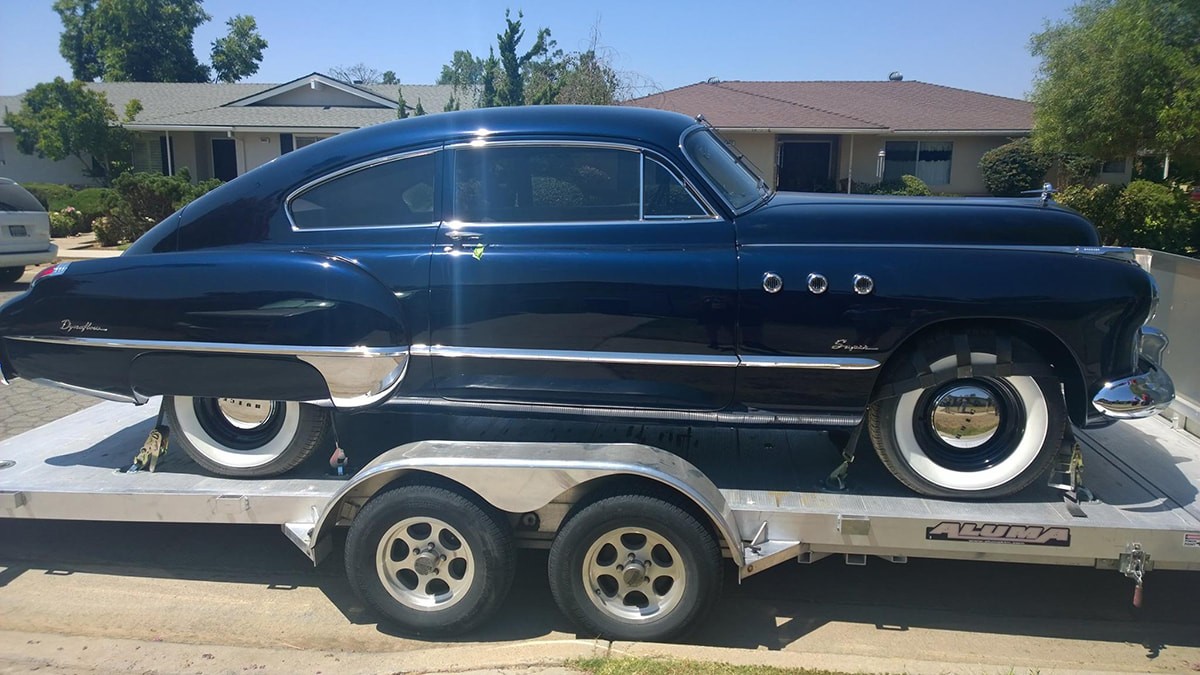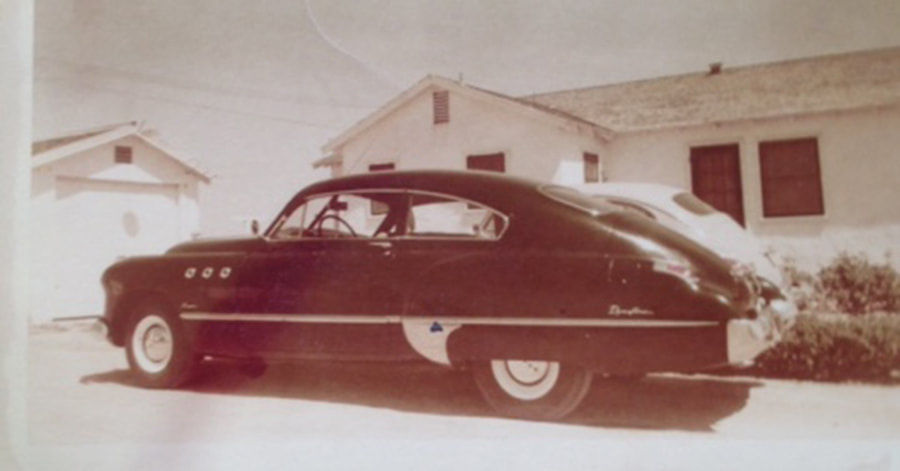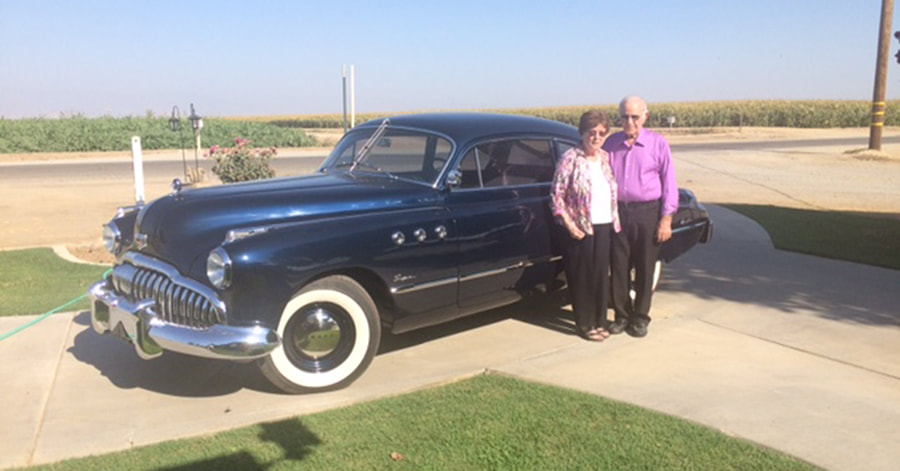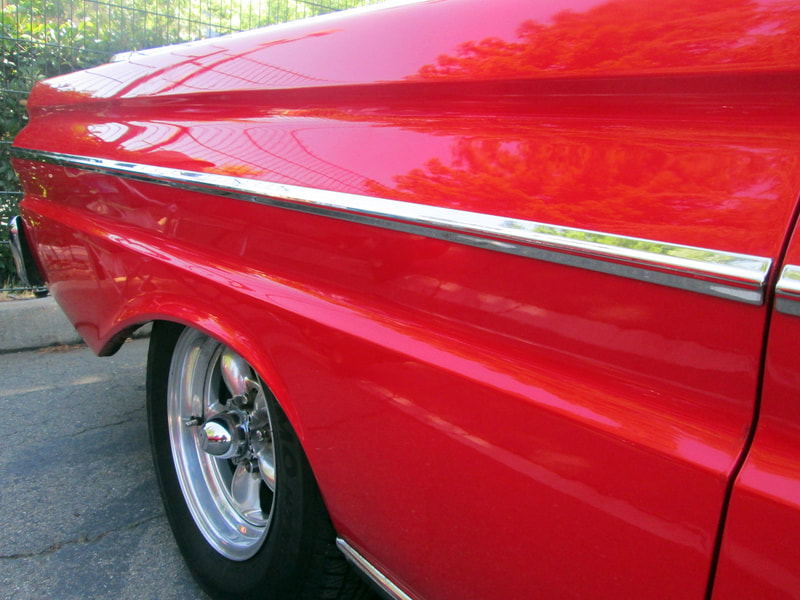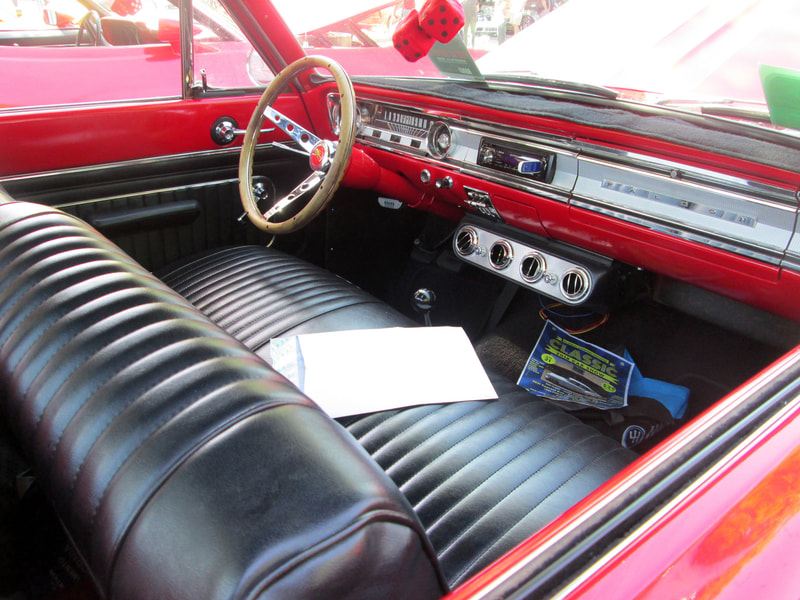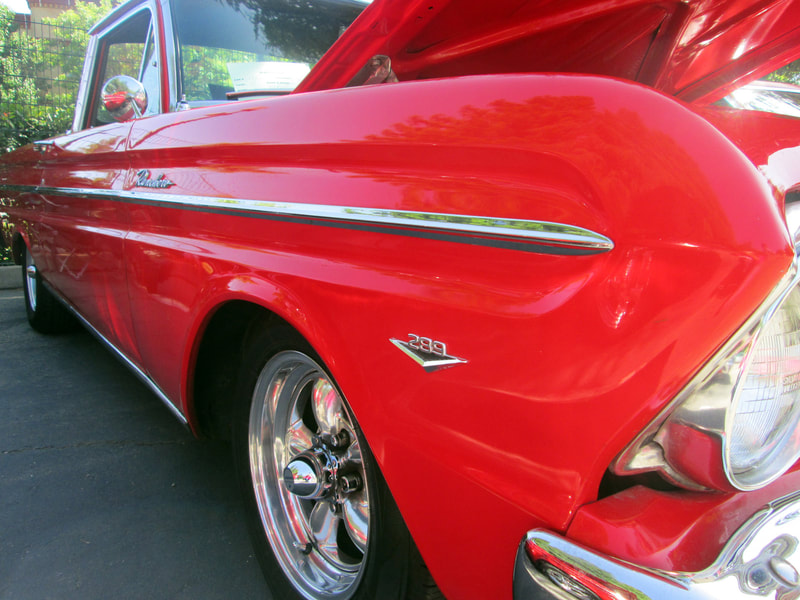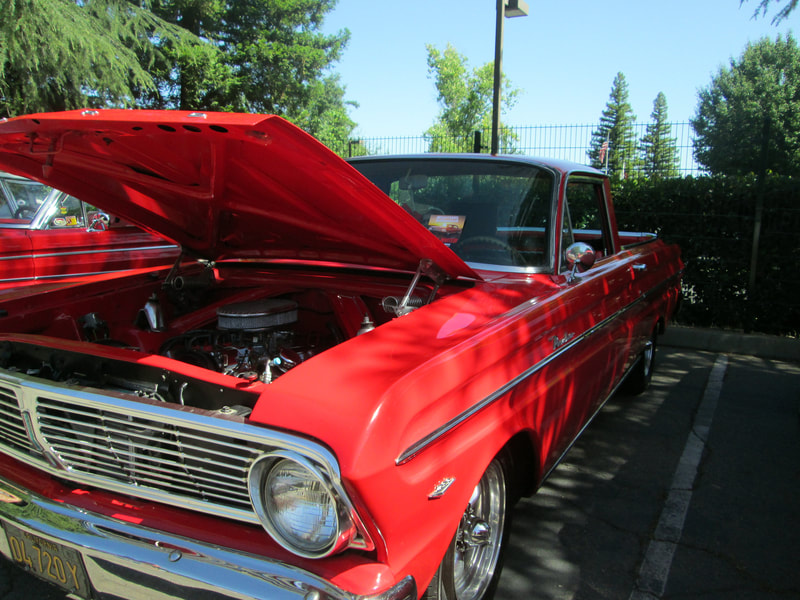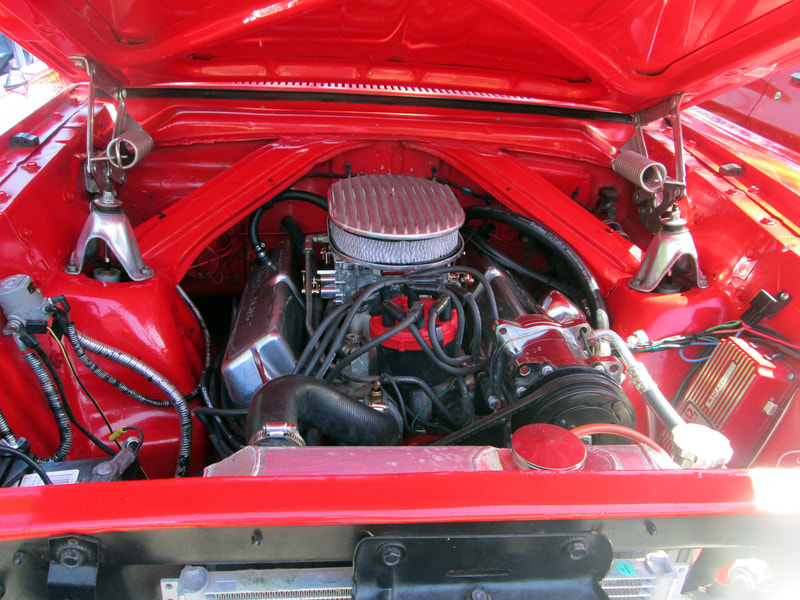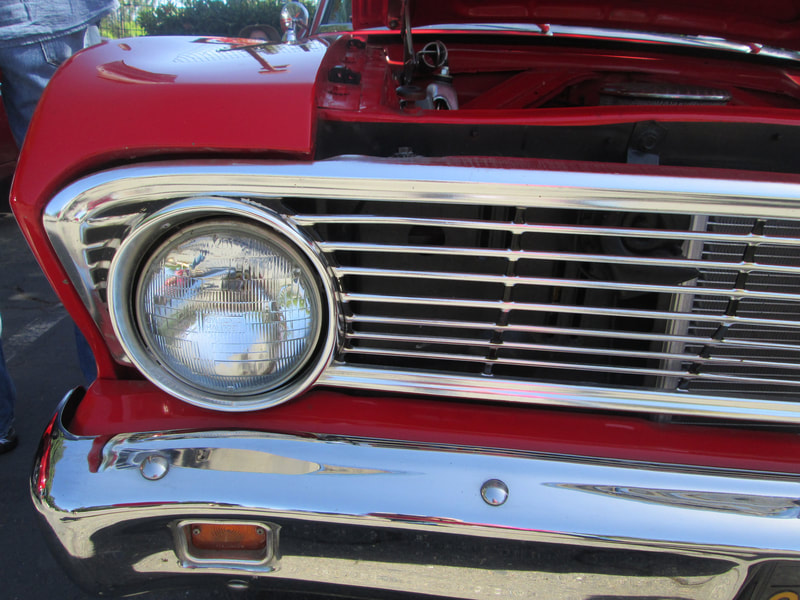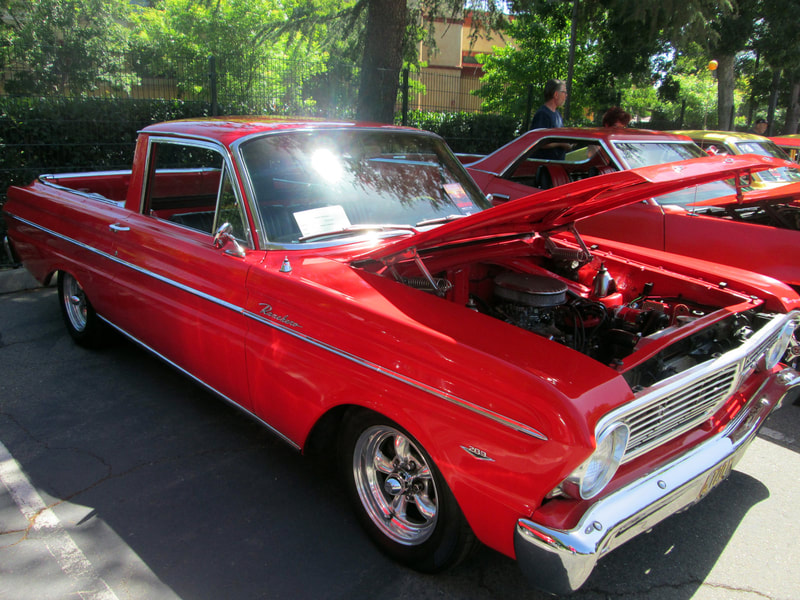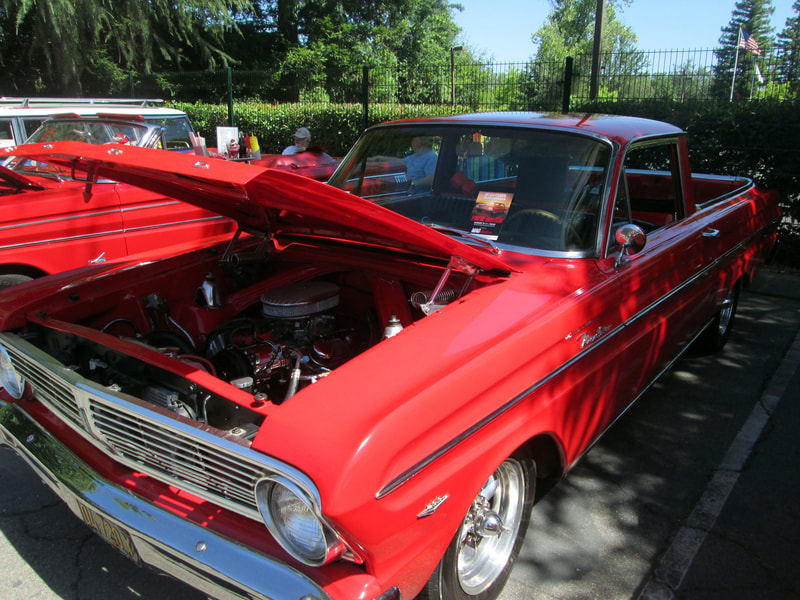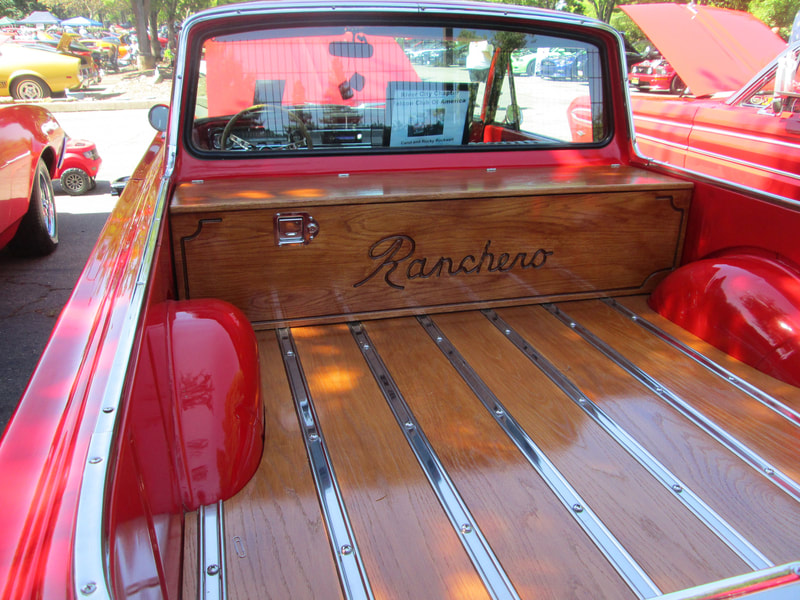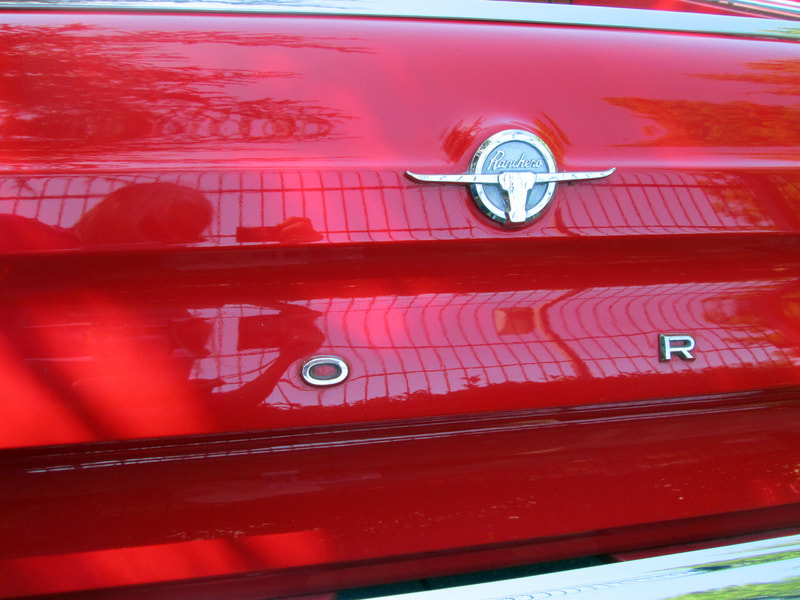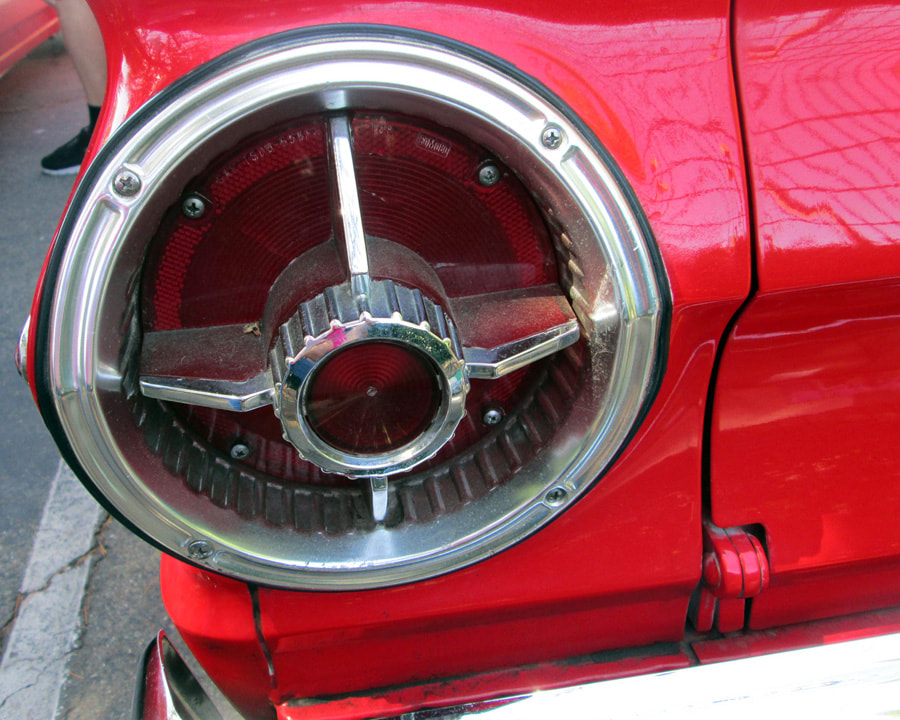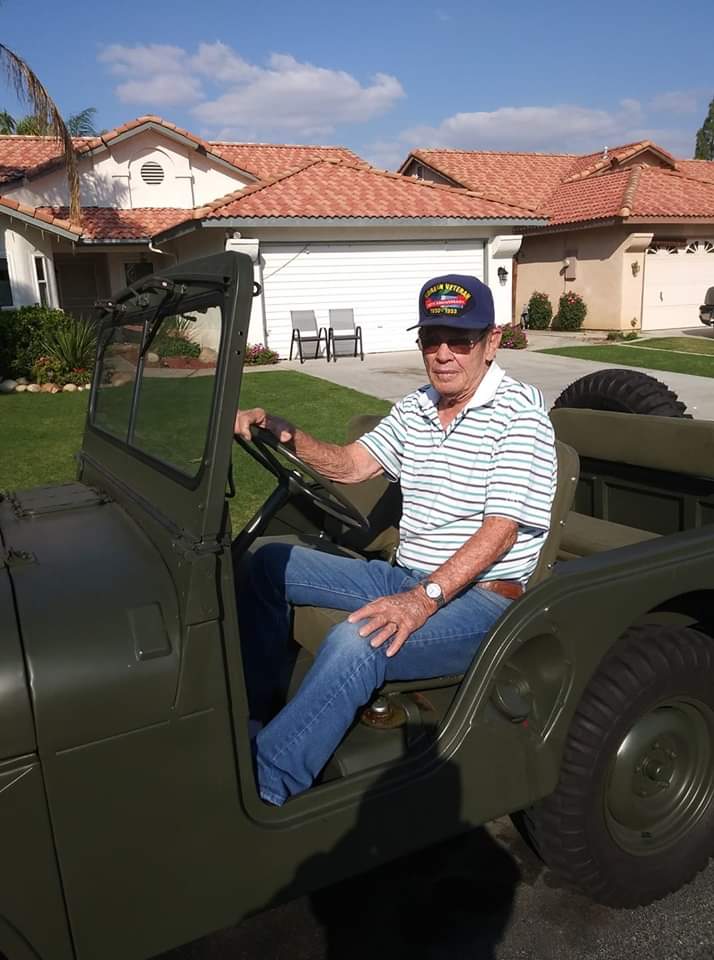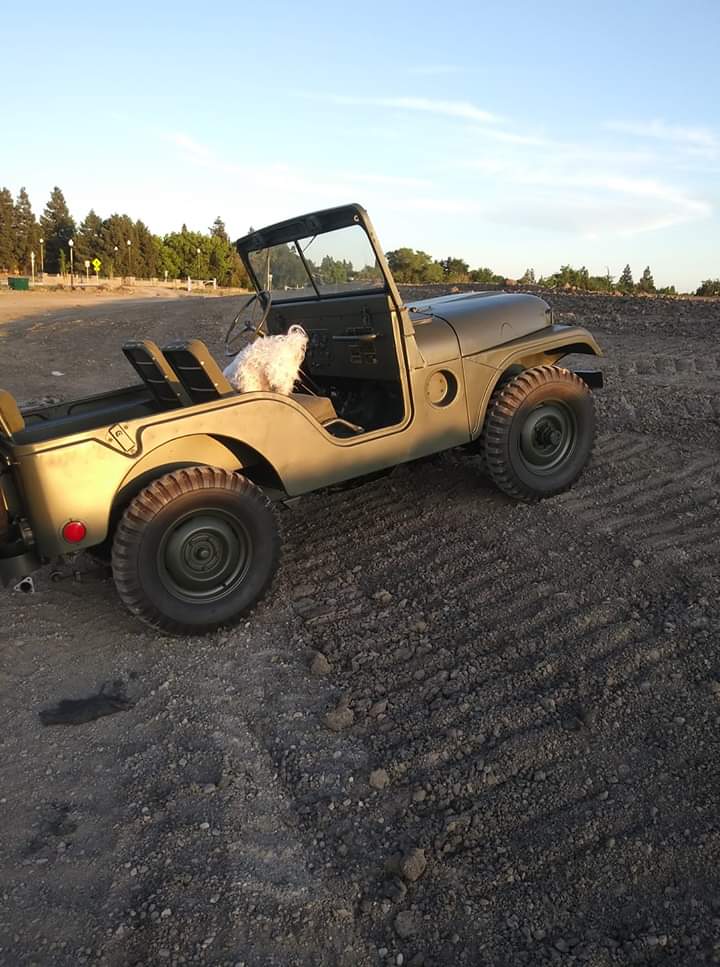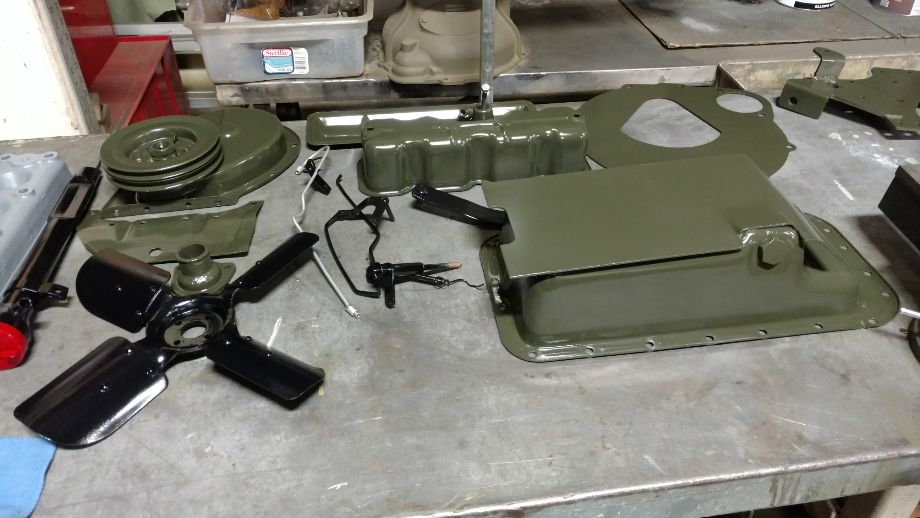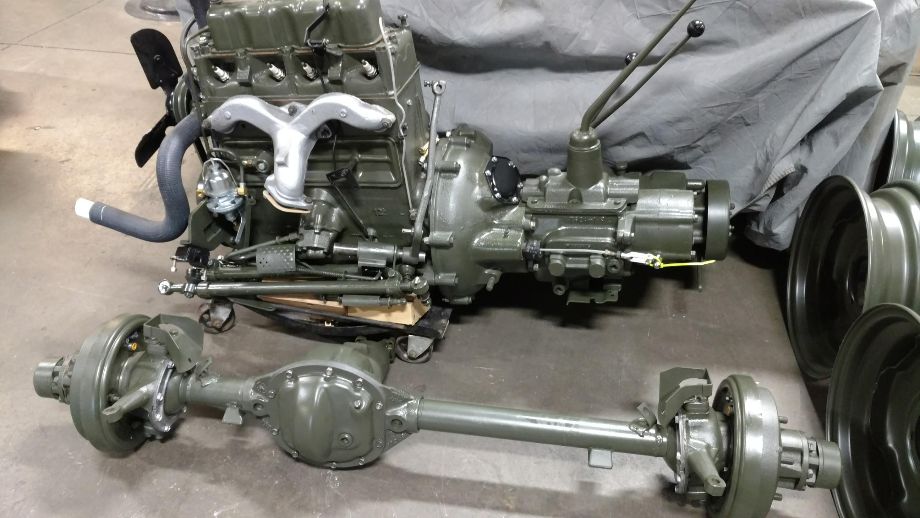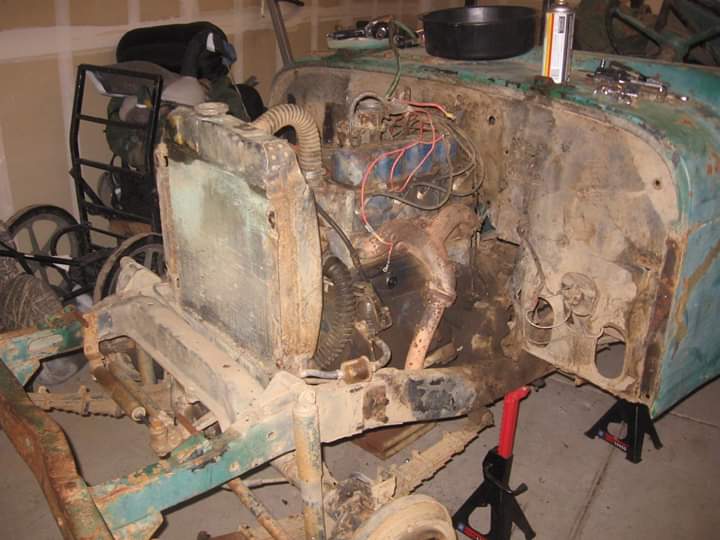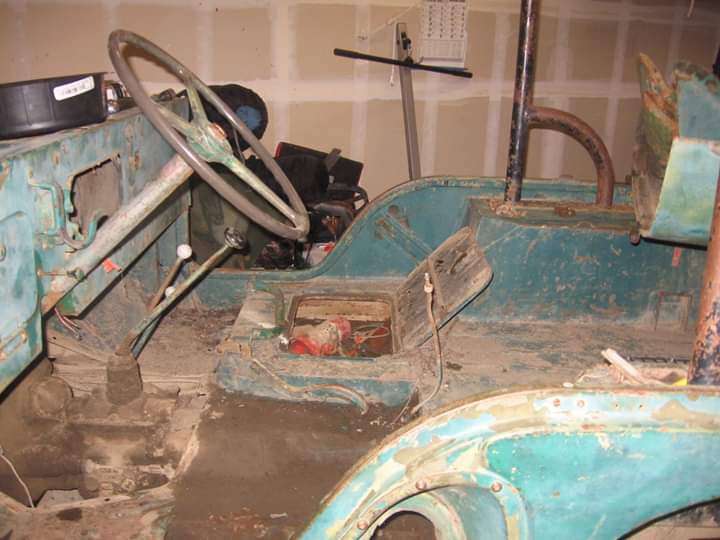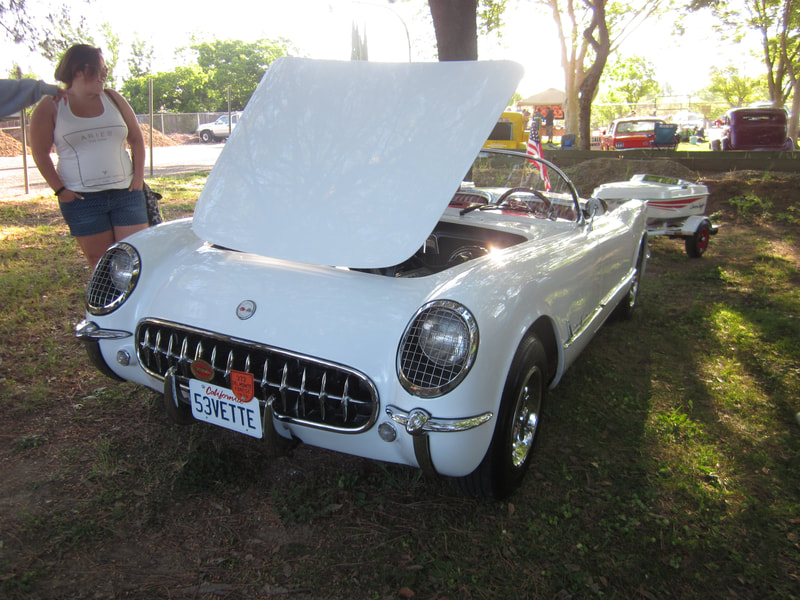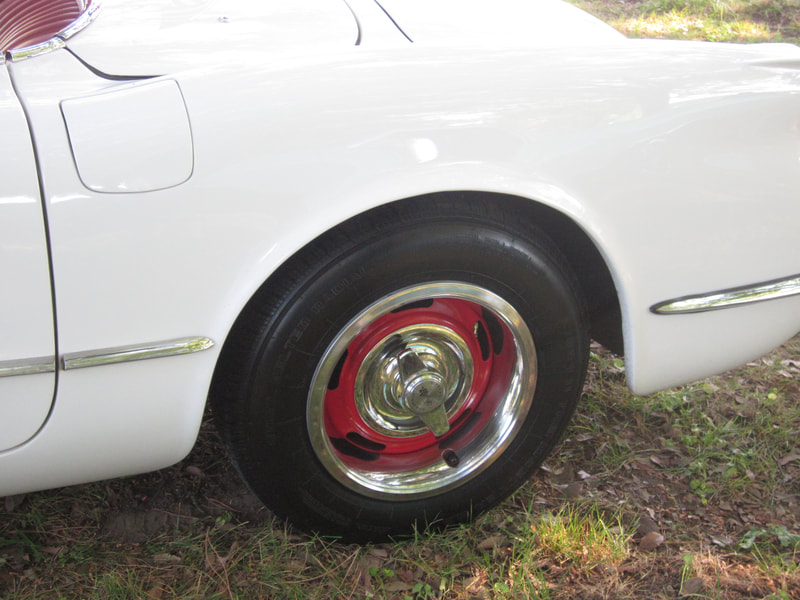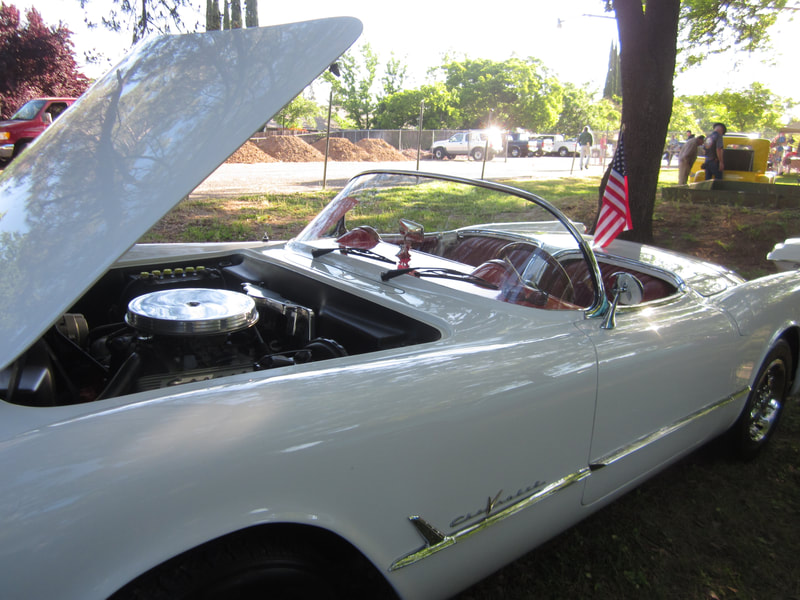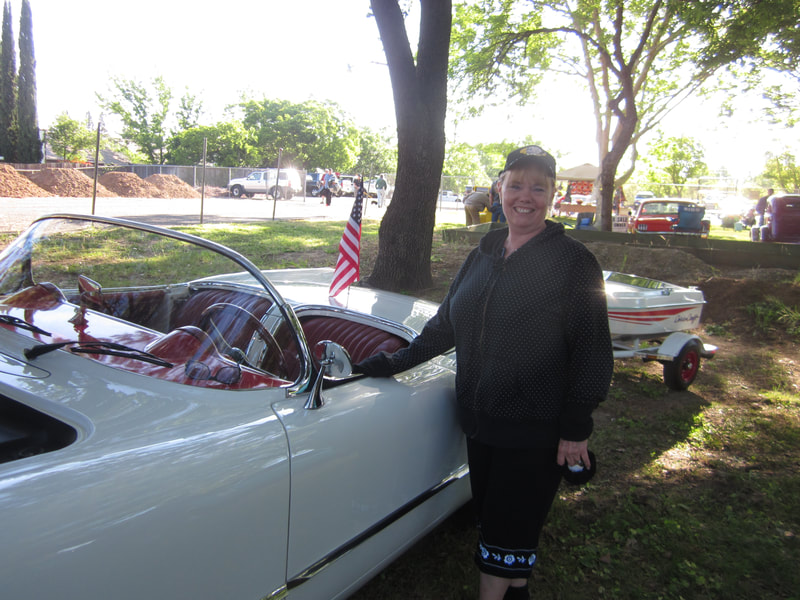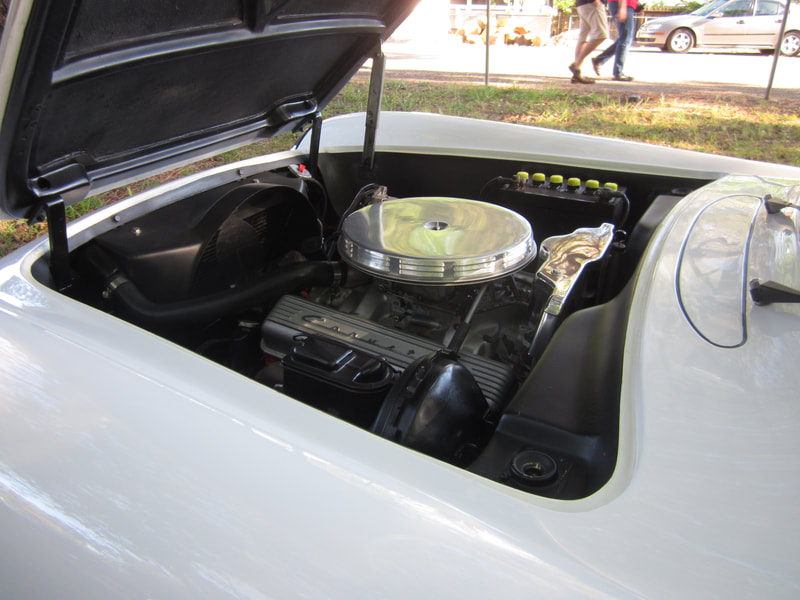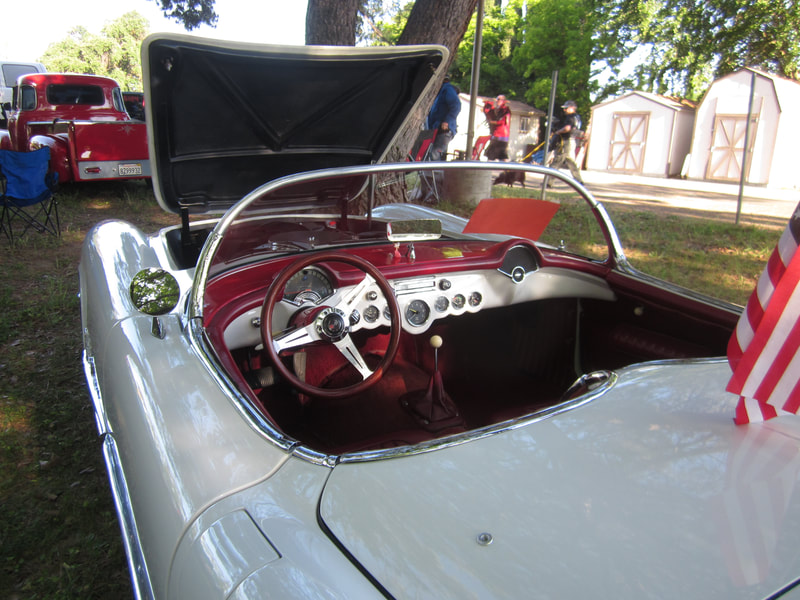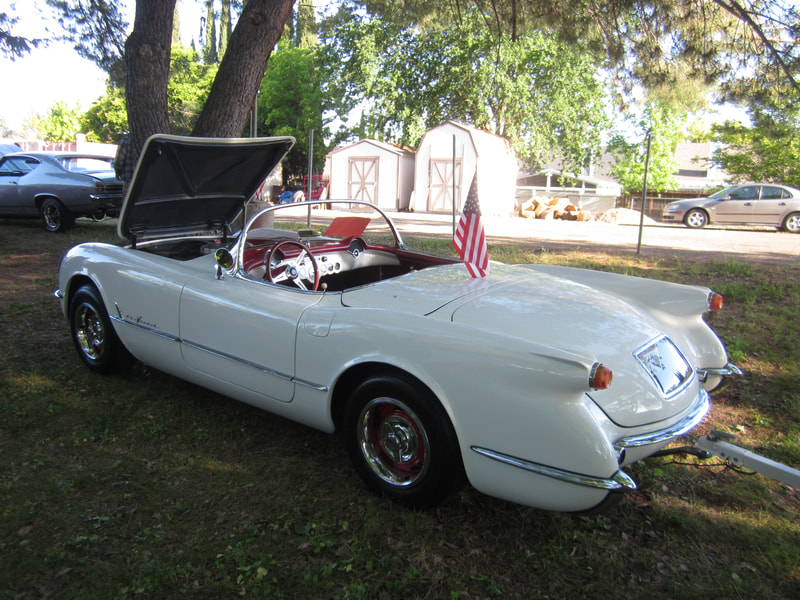|
Chuck Bettinger’s 1955 Ford Thunderbird used to be red. Really red. Torch red, the color Ford used in the 1950s, almost a fire engine red. That color didn’t work so well for Bettinger who chose to transform the car to the stock T-bird blue it sports nowadays, and that color might be why he refers lovingly to his car as a cream puff.
Getting it from that red to the much calmer blue, which Bettinger says looks green to him, and does look green when the sun’s hitting it at that certain angle, wasn’t an easy or quick job. He couldn’t just take it to the drive through paint shop. The car was literally taken apart from top to frame so that it could be restored to Bettinger’s taste. His wife thought she’d like to have the car, but she’s driven it only one time, saying it’s still a hot rod. Perhaps it is, but it’s a hot rod sporting many conveniences not found on the original – air conditioning, rack and pinion steering, and disc brakes. “But it still looks like a ’55 T-bird,” Bettinger gladly stated when he showed the car recently at the 22nd annual Sacramento Mustangs & Fords at the Marriott show sponsored by the Sacramento Area Mustang Club. Show proceeds benefitted the California Automobile Museum’s new roof fund, the Automotive Student Service Education Training (ASSET) Scholarship Foundation at Cosumnes River College, and the Rancho Cordova Police Activities League program. He towed it down in a specially designed trailer that was on the street not far from his spot near the entrance. Originally built for comfort, not speed, this was Ford’s first two-seater in nearly two decades. It was lightweight, sported fender skirts and the removable fiberglass hard top which was standard. The soft cover had been optional. Bettinger discovered the car in the back of a shop, not entirely in one piece. The vehicle, he learned, originated in Kansas City and was that infamous torch red when first sold in 1954. Bettinger’s a record keeper, a necessity in his long career as a mechanic at the Oroville Dam powerhouse, which he began in 1961 before the first concrete was poured there. The vehicle remained in one family, passing through several members before Bettinger came into possession of it. It’s been his for a little over a year and a half and he’s documented the entire restoration project, which is kept in a photo album he pulled from the trunk. The project wasn’t quick because restoration projects, he explained, take a back seat to the more lucrative business of collision repair. And it’s difficult, Bettinger explained, to find someone to do the complete body. “The biggest thing was waiting to get the body back,” he said, explaining also that the body was walnut-shelled, meaning that it was sand blasted with crushed walnut shells. This process can cause less stress to the vehicle, and it is often used for cleaning jet engines or even for cleaning carbon build-up in passenger cars. The hard top is the same blue as the exterior and he painted the dashboard the same color because he likes the monochromatic color scheme, which is disturbed only when he replaces the hard top with the tan soft top from a 1956 model. The car, this day, was topless. A self-healing protector was added to save the body from additional wear from the removal and install of the tops. He’s owned the car about the same amount of time as it took to restore. The air conditioning system from Classic Auto Air was installed under the dash. The car runs a 340 hp, 302 engine and has hydroboost. And it’s for sale. In fact, several folks discussed the merits of the vehicle with Bettinger while he was showing. The sign, like Bettinger, is quiet. This brought to you by http://autobodyexpressions.com/ Story and Photos by Trina L. Drotar
1 Comment
“My dad bought that car new because he was getting married,” said Tom Barcellos who surprised his folks and the rest of the family with a restoration project taking nearly two decades and as many twists and turns as a mountain road. “That was their honeymoon car,” he added.
Barcellos has the original pink slip and said that the car has remained in the family for nearly 70 years. When the folks purchased a 1959 Buick, the honeymoon car was given a new job as lunch wagon. “I was five or six years old, riding in the passenger seat, holding a plate with my dad’s lunch of hamburger or small steak with waxed paper over it, a thermos with a cold drink and some coffee. There was no Tupperware at that time,” Barcellos said. Five generations have called Barcellos Farms home and work. Barcellos lived in a remodeled home that had belonged to his grandparents not far from the barn where the honeymoon car collected dust and rust over the decades. “It was rotting away, wasn’t worth anything except sentimental value.” The car never left the farm until Barcellos began the restoration process. He reached out to cousins and friends for assistance. The early years in the restoration process were wrought with setbacks, but Barcellos never gave up hope. When one route was shut down, he’d look for an alternate. Years passed and Barcellos explained that EBay became a major source for parts, many still boxed. They were new, old stock. Shortcuts in the restoration process were as much of a no-no as they would have been in farming. “I wanted to restore the vehicle to original. The motor was overhauled in Tulare. The guy came out of retirement to do this job,” he said. The color, a blue-purple in sunlight and almost black otherwise, is the closest match, he explained, to the original color without the lead-based pigments. “Pictures don’t do it justice.” Even the interior sports the same color and pattern as the original. More recently, finding parts online has become easier. “Parts are readily available if you have the time and ability to search,” he said, adding that “one guy knows another guy.” That’s how he found many of the suppliers and assistants. The glass firm was in Washington and offered to drop ship. The car was in California, two miles from where the glass was cut. The upholstery shop was across the street. Some things just fall into place when they need to. His regret is that there were few pictures documenting the restoration process, but those of his mom and dad and their faces upon seeing the newly restored honeymoon Buick were, as they say, priceless. “We had one like that,” his mom said after the unveiling in front of the clan who’d gathered in early August for the annual birthday celebrations. “Mom, that is yours,” he said. Barcellos said that his parents (now 86 and 92) hadn’t known about the restoration and that the car had been out of sight for so long that no one really thought about it. There are a few more things to do – the exhaust system needs finishing and the steering column needs a bit of work, but then he’ll drive his parents in their honeymoon car once again. Story and photos by Trina L. Drotar https://www.autobodyexpressions.com/ When the 1964 Ford Falcon Ranchero was released, Beatlemania was racing across the U.S., and Rocky Rockwell told his wife that he was going to buy one. “We can’t all get in it,” she told him, so they settled for, as Rockwell put it, a regular car.“ I told her someday I’m going to get me one of those,” he said with an infectious smile. Fast forward nearly half a century after the sons were grown. Rockwell stumbled upon a 1965 Ranchero in Campbell, California, not far from where he’d lived in San Jose. Rockwell went down to take a look at the car. The owner wanted $2200.00 for the vehicle. “Man, that’s too much. I gotta do all this work,” he told the seller. He offered $1600.00 and was promptly laughed off the street. The vehicle had been owned by a guy who hauled trees. The car was a mess, but there was no rust, which can be a problem in many areas. Rust begins on the surface, can weaken the metal over time, eventually penetrating the metal and forming holes. Repairing these problems can be costly, sometimes too costly, for restoration work. A couple of months later, he received a telephone call from his sister. The car was still for sale in Campbell. She’d been driving by and noticed the sign. Rockwell’s brother-in-law asked if Rockwell would mind if he bought the car because “I can fix that one easy.” “Well, no.” “Why don’t you just give the guy what he wants?” Rockwell phoned his sister and asked her to offer the guy $1800.00. She offered the seller the original amount. “He took it,” Rockwell said, grinning , “so I got it for $1600.00.” Patience paid off. Rockwell let his brother-in-law do most of the restoration, cleaning the floor board with a simple steel wool pad and some elbow grease. Only one part required replacement. “I guess I was smart buying it,” Rockwell said. The restoration has been a slow process of a little here and a little there, or as Rockwell says, “little by little.” The drum brakes were changed out for disc brakes and they installed a 5 speed transmission from a Ford mustang. The car was just about the way Rockwell wanted it. One day, while at a car show, he noticed that his Ranchero sat higher than another one, so he switched out the axle for a fat boy axle and lowered the car down just a bit. Then, he explained, he was really happy with the car. The bed still needed work and his brother-in-law came to the rescue again, stopping Rockwell from buying a kit. He offered to make the bed since he’s a cabinetmaker. The bed is wood and is certainly a centerpiece on the vehicle. “And then he put that box in it, which is nice because I can put my chairs in it.” The toolbox sits right behind the cab and fits perfectly, having been custom built. Then Rockwell was really happy and felt it was the way he wanted it. Any parts for the car were pretty easy to find, Rockwell said, except for a strip of trim he needed. He found the trim at Falcon Enterprises. The car is currently torch red, a Corvette color which is more orange than Ford’s torch red. Rockwell had wavered between a couple of colors until it was time to paint the engine compartment and he was forced to decide. Rockwell is semi-retired from his lawn maintenance service company, but he works a little here and a little there in case he wants anything else for the car. “Now I’m satisfied with it,” he said with that same infectious smile that invites you to take a seat and sit a spell.
Story and photos by Trina L. Drotar https://www.autobodyexpressions.com/ Jeff Rogers’ interest in the Willy’s M38-A1 goes back to camping and hunting trips he and a buddy used to take.
“The thing was just fantastic,” he said. The jeep rolled and was totaled. Jeff moved to Colorado, returned to California and while out with his kids, he spotted a jeep on a trailer with a for sale sign. It brought back memories of those earlier trips. He located the owner, a California wine grape grafter who shared stories about grapes and his father who’d been in occupied Germany. As Jeff turned to leave, the man told him to make an offer. Jeff posed $500. The man countered with $2500. Jeff pointed out damage to the old jeep. The pair agreed to $900. Jeff rented a U-Haul trailer, loaded the jeep, and brought it home. “I immediately started tearing it apart,” he said. “I must have gotten ten five-gallon buckets of dirt off it,” adding that he scraped and hosed and wondered if the dirt would ever come off. A whole lot of elbow grease and paint remover led to the discovery of the original Toledo Ohio Willy’s factory data plate. “It’s got the original number on it,” he said. Next up was to dismantle the jeep so that it could be reassembled. The hinge in the back frame was cracked and had been welded several times. He accidentally cut a piece of the frame off while trying to cut through the welds. Once repaired, he took the frame to have it sandblasted and primed and ordered a new support from Atlanta. Jeff enlisted the help of his kids to finish tearing down the vehicle, and then hauled buckets of parts to a guy who would put the jeep back together. Six months later, the 1952 M38-A1 Jeep was whole and running. Jeff’s had it for about 8 years and regularly drives it to work and here and there, including a couple of long distance trips. The M38-A1 was named after his paternal grandmother, Nellie. He’d hoped to drive his father, a Korean War veteran, for a trip down memory lane. “My dad went into the Marine Corps in 1952 and served during the Korean War, and this jeep is a 1952 so I was hoping to get together and give him a ride in it so he could remember. I’m sure he drove one of them when they were brand new.” His father passed away before the ride, so Jeff gave his uncle, also a Korean War veteran, the ride. Uncle Sonny said it looked like it just rolled off the assembly line. Nellie’s T90 transmission, one of many A1 upgrades, is great for four-wheelers, said Jeff. The A1, he added, shifted from a flathead engine, flat fenders, flat hood, and low horsepower to a domed hood, rounded fenders, and a whole lot more horsepower. “It has a whopping 74 horsepower in it.” The top speed is 60 mph but Jeff’s been advised to keep it at 45 or less. His uncle said they beat walking. The engine compartment is lean, clean, and mean. Original parts were cast iron and very heavy. Jeff’s reverence for the vehicle leads him to search for stock parts. “It’s as close to original museum quality as possible. There’s nothing contemporary on it.” He even located a grill that was still in its original unopened crate. The old grill, he said, was so badly rusted that he cut it off and now has it hanging in the garage as wall art. Goals include taking Nellie camping and playing around the mountains. When he does, he’ll have the top off and the wind blowing through his hair. She’s an attention getter, though, and people often stop him, so it might take a really long to reach the mountains. Story by Trina L. Drotar Photos courtesy Jeff Rogers https://www.autobodyexpressions.com/ Collette Young’s – 1953 Corvette Collette Young purchased her 1953 Corvette in 2001. One of only 300 ever produced, each fiberglassed by hand, Young’s car sports the same polo white exterior as the original, along with the same red interior and black soft convertible top, although she did add a few things that might make traditionalists cringe a bit. She was drawn to the car because it was designed the year she was born, even though the first cars didn’t come off the production line until June of 1953. “The lines and the fins,” she added, “make the car look sleek and sexy.” It’s also the perfect fit for Young’s shorter stature. The 1953 Corvette was one of the first sports cars in the era, and Young explained that it almost went extinct, due in part to lackluster engine performance. Most buyers, she continued, “were Chevrolet dealers, dignitaries, people like John Wayne.” Young explained that it would take another couple of years and competition from the Ford T-Bird for the Corvette to really take off. As for the lineage of Young’s car, she’s traced that through a Sacramento auction to the buyer in Oroville to another owner in Alabama. “It’s probably one of those situations where it was a dealer car,” she said. “It was pretty ugly when we bought it. It was missing some parts and the engine was pretty ugly. “It had a tired 350 in it and whoever put it in did a horrible job,” she said. Instead of restoring the model’s original Blue Flame 6, due to unavailability and cost of parts, Young decided to stay with the V8, opting for a 283. Within a year of purchase, which included six months of restoration work, the car was stolen after the first show and wrecked, its back end destroyed and the body riddled with rock dings. “We took to the car back to Chico to a friend of ours who has an auto body shop there,” she said. “It spent the entire next year in the shop getting completely redone.” Contemporary fiberglass and hand sanding make the car look better than the original she explained. Replacement bumpers and trim weren’t easy to find, so some body pieces were sent out for straightening and re-chroming. The Youngs continue to attend several car shows each year, recently showing in Los Banos Story and photos by Trina L. Drotar https://www.autobodyexpressions.com/ |
Proudly powered by Weebly

